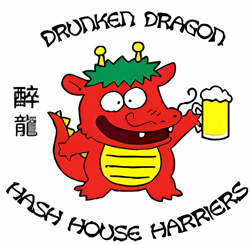WHAT`S HASHING
Hashing . . . it's a non-competitive mixture of athleticism and sociability, hedonism, exercise and fun; a refreshing break from the nine-to-five routine. Hashing is an exhilaratingly fun combination of running, orienteering and partying where a pack of harriers and harriettes follow a trail set by a hare through town, country, jungle and desert all in search of exercise, camaraderie and good times.
Hashing, as we know it today, began in Kuala Lumpur, Malaysia, in 1938, when a group of restive British company men started a hare & hounds running group. They named the group after their meeting place, the Selangor Club, aka the "Hash House."
Hash House Harrier (H3) runs were patterned after the traditional British public school paper chase.
A "hare" would be given a short head start to blaze a trail, marking his devious way with shreds of paper, soon to be pursued by a shouting pack of "harriers." Only the hare knew where he was going . . . the harriers followed his marks to stay on trail. Apart from the excitement of chasing down the wily hare, solving the hare's marks and reaching the end was its own reward, for there, thirsty harriers would find a tub of iced-down beer.
Hashing died during World War II (Japanese occupying forces being notoriously opposed to civilian fun), but came back to life in the post-war years, spreading slowly through Singapore, Indonesia, Australia, and New Zealand, then exploding in popularity in the late 70s and early 80s. Today there are thousands of Hash House Harrier clubs in all parts of the world, complete with newsletters, directories, and regional and world hashing conventions.
Despite its growth, hashing hasn't strayed far from its British and Malaysian roots. A typical hash is a loosely-organized group of 20+ men and women who meet weekly or biweekly to chase the hare or more commonly follow a trial set a little earlier. We follow chalk, flour or paper and the trails are never boring. When forced to, we'll run the occasional street or alley but in general we prefer “shiggy” - footpaths, fields, woods, bogs, streams – you name it. Every so often the hare will set a “check” where the trail stops, usually at a junction of paths and the faster runners then have to search out where the trail picks up again. When they do they call “On On” to let those following know which way to trail goes. This way the slower runners (or even walkers) can catch up. A well laid trail aims to get all runners back at the starting point at roughly the same time regardless of the runners speed or fitness.
At the end of the run refreshments are available, usually beer, although some of today's health-conscious hashers may shun a cold beer in favour of water or a diet soda. Regardless, trail's end is always a party where the hares are thanked (or castigated if the run was a bad one) and any misdemeanours perpetrated by any of the pack are celebrated with a down-down!
Perhaps that's why they call us the "drinking club with a running problem!"
So . . . if you'd like to spice up your running program with fun, good company, new surroundings and a physical challenge, try hashing.






